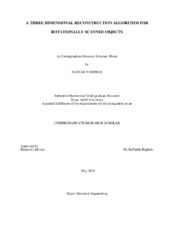| dc.description.abstract | Ultrasound imaging is a medical modality that uses high frequency sound waves to produce high resolution images of internal tissues’ structures. Since ultrasound images are captured in real time, the modality provides a refined method to analyze internal organs such as liver, kidney and heart. Ultrasound imaging is relatively inexpensive and safe compared to other imaging modalities. So, it is used for diagnosis of a wide range of diseases.
One of the emerging techniques in the ultrasound imaging field is three-dimensional (3D) imaging. Typically, ultrasound transducer arrays are used to capture 2D views of the tissue under investigation. 2D images can be clinically useful. However, it is sometimes difficult to visualize the entire surface of an organ or tissue’s abnormalities using only 2D images. Additionally, 2D images can be difficult to interpret. Therefore, obtaining 3D volumes or snapshots of the tissue of interest can greatly help the diagnosis of diseases or abnormalities. Creating 3D volumes may be a very useful tool in clinical practices and is often used in obstetrics, cardiology, cancer imaging and image-guided surgeries.
In order to generate 3D volumes, a set of 2D ultrasound images needs to be acquired first. The 2D images can be obtained using an imaging probe capturing the tissue from different angles. Then, a reconstruction algorithm is applied to the data to produce a 3D volume. This thesis focuses on the development and analysis of a 3D reconstruction algorithm that uses 2D ultrasound images acquired using a transducer that is scanned rotationally. The algorithm is validated using experimental data obtained from phantoms of known geometry. The results of this thesis show that the proposed algorithm can be used to reconstruct 3D volumes of the controlled phantom with high accuracy. While more experiments are needed to fully understand the limitations of the algorithm, these preliminary results suggest that, in the future, this algorithm may also be used for 3D imaging of biological tissues. | en |


